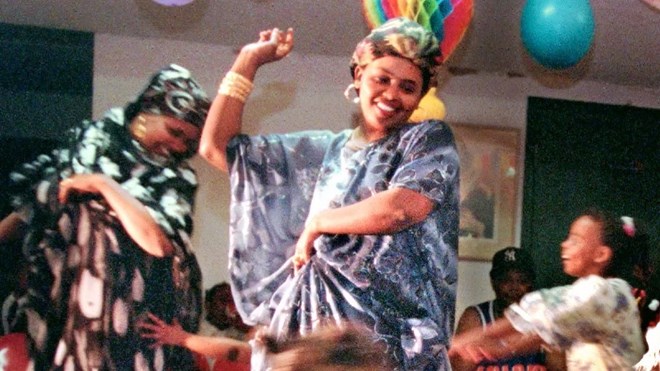
Sunday January 29, 2023
In our series of letters from African journalists, Ismail Einashe considers how important protest music is to the Somali culture of survival.

Growing up in Hargeisa, capital of the self-declared republic of Somaliland, in the early 1990s I loved nothing more than sitting with my aunt in our bombed-out house lip-syncing to songs that sum up the Somali spirit of resistance.
Listening on our battered old cassette player, one of our favourite stars was Saado Ali Warsame, whose voice will always be remembered by Somalis as one that was critical of the military regime of Siad Barre.
Using rich metaphors, she was scathing of the junta that drove luxury vehicles as most many went hungry - and it was one of her songs, Landcruiser, that fuelled feelings during the civil war that led to Barre's overthrow in 1991, after which Somaliland seceded from the rest of Somalia.
During that brutal conflict military forces literally flattened Hargeisa - once regarded as the city of modern Somali music and culture where anti-colonial protests first began.
It had the largest public library in the country, boasted a beautiful Chinese-built theatre and had various musical performance spaces for what was a thriving music scene.
Somali music is distinctive - it has the rich sound of the oud, other stringed instruments, drums and empowering lyrics that come from the country's oral story-telling tradition and love of poetry.
Thirst for freedom
It was in the 1940s that modern Somali music really came into being with a musical style pioneered by Abdi Sinimo, known as "balwo" - which in Somali means "overcoming misfortune".
Sinimo was a long-distance lorry driver and the story goes that when his vehicle broke down one day, he composed a song while he was fixing it.
His spirit of overcoming gave birth to a music revolution that encompassed great musicians like Hudeidi, known as the "king of the oud", and Abdullahi Qarshe, whose 1957 hit Every Nation Has Its Own Flag was adopted as Somalia's national anthem 53 years later.
Composed a few years before Somalia's independence in 1960, the song reflects the thrust for freedom that was sweeping the continent.
Independence saw great investment in education and the arts and the 1970s proved a golden era for Somali music, with hotels in the capital, Mogadishu, such as Al-Uruba and Jazeera Palace, hosting exhilarating live performances for young people decked out in Hendrix-style Afros and bell-bottom jeans rocking to groups like Wabeeri and Iftin.
Wabeeri came out of the state-run National Theatre and involved a huge troupe who also toured to international acclaim.
The female performers were on stage with heads uncovered and brought stardom to singers likes Magool, who famously sang O Sleeping Africa at a summit of the Organisation of African Unity (OAU) in Mogadishu, powerfully warning the leaders of the continent's young nations about the threat of neo-colonialism.
Another Wabeeri member to find fame was Maryam Mursal, one of the first Somali singers to mix traditional music with modern jazz, who appeared with US legend Nina Simone.
At this time then-President Barre used music as a tool in his Stalinesque propaganda machine and singers were forced to perform pro-regime songs.
Though the disco Dur Dur Band clearly bulked at this. Not funded by the government, it became one of the most popular groups of the 1980s with its eclectic funk sound and fashion flair, shrugging off politics.
When Somalia collapsed into anarchy after 1991, its band members, like most musicians and many hundreds of thousands of others, fled the country.
At home music has faced a tough time especially over the last 17 years with hard-line Islamists seeing it as un-Islamic.
The al-Shabab militant group, which still controls large areas of the country, bans the playing of music.
Saado Ali Warsame, the renowned singer who returned to Somalia in 2012 to become an MP, was shot dead by al-Shabab two years later in a targeted killing.
Yet Somali music has continued to evolve - in the diaspora and at home.
Viral boom time
Take K'naan, the Somali-Canadian rapper who had success with his Wavin' Flag 2010 World Cup hit - and whose aunt was Magool.
He has recently collaborated with home-grown viral sensation Sharma Boy with Waayo Waayo, which translates as "The Good Old Days".
It is a global hit, with almost six million views on YouTube, sung and rapped in a mix of Somali and English - and tells an inspiring story about hard work, perseverance, resilience and looking forward to a bright future.
Its optimistic outlook reflects the fact that music is once again booming in Somalia - with live music events back in Mogadishu and Hargeisa.
For me the singer who truly reflects the fighting spirit of Somalis remains Maryam Mursal. Her beautiful melodies, life story and powerful lyrics speak to me like no other.
In 1998 she released The Journey on Peter Gabriel's Real World Records label. The album documents her own tale of escape with her five children in the early 1990s - a seven-month journey from Somalia to Denmark.
She memorably captured this experience in the song Qax (meaning "Refugee") - a ballad that resonates powerfully with many Somalis forced to bear the pain of war and exile.
I was lucky to once see her on stage in London. Dressed in her long "dirac" dress, colourful head wrap and gold bangles with her arms extended out to the audience, she belted out her hit song Somali Udiida Ceb (Somalia, Don't Shame Yourself).
It is about the "richness" of the Somali landscape "destroyed" by conflict. She ended the song by extolling Somalis to put their differences aside and work together to rebuild a shattered country.
"Oh! You Somali people - try very hard to restore peace, do not accept shame and reject disrespect."
It is a sentiment many Somalis around the world still embrace.